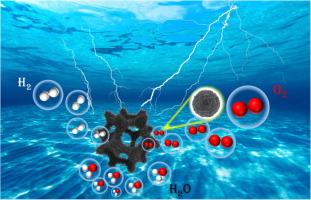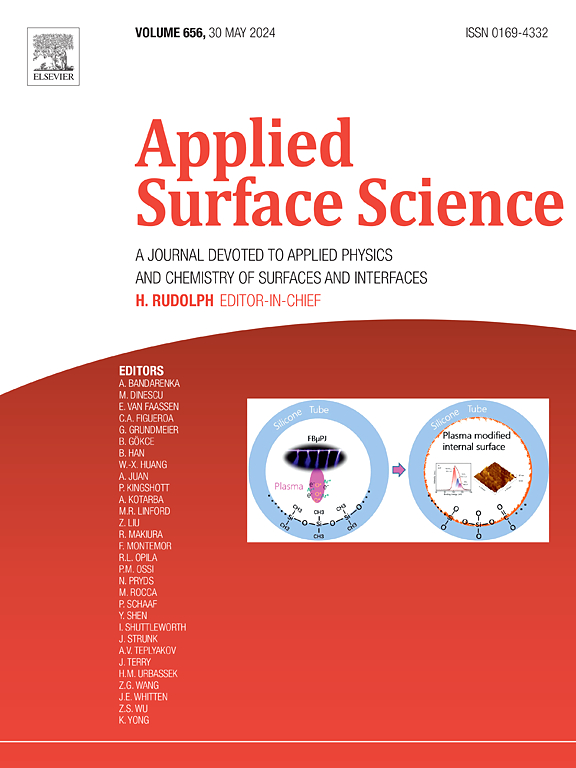Modulation of oxygen vacancies in NiFe layered double hydroxides through dual-doping with Mo/Cr cations for efficient seawater hydrogen production
IF 6.3
2区 材料科学
Q2 CHEMISTRY, PHYSICAL
引用次数: 0
Abstract
Seawater splitting to produce hydrogen holds promise for renewable energy but faces challenges from chloride ions, causing electrode corrosion and competition between chlorine oxidation reaction (ClOR) and oxygen evolution reaction (OER). Therefore, it is crucial to develop highly efficient and stable electrocatalysts for seawater splitting. Here, we employ a dual-doping strategy of Mo/Cr cations and a sulfuration approach to fabricate the S-MoCr-NiFe@NF bifunctional catalyst with a 3D nano-flower structure. The S-MoCr-NiFe@NF catalyst exhibits remarkable catalytic performance for the oxygen evolution reaction (OER) in 1.0 M KOH + 0.5 M NaCl and 1.0 M KOH + Seawater, achieving current densities of 10 mA cm−2 at low overpotentials of 116 and 141 mV, respectively. Furthermore, it was demonstrated that the S-MoCr-NiFe@NF catalyst exhibited remarkable performance in alkaline overall seawater splitting, requiring only 1.48 and 1.57 V to achieve current densities of 10 mA cm−2 in 1.0 M KOH + 0.5 M NaCl and 1.0 M KOH + Seawater, respectively. The in-situ Raman and DFT calculations confirm Ni as the primary active sites, reducing the energy barrier of the rate-determining step and enhancing OER performance. This study will offer a viable approach to developing and creating highly effective bifunctional catalysts for seawater splitting.

通过钼/铬阳离子双掺杂调节镍铁层双氢氧化物中的氧空位,实现高效海水制氢
海水裂解制氢有望成为可再生能源,但面临着氯离子造成的电极腐蚀以及氯氧化反应(ClOR)和氧进化反应(OER)之间的竞争等挑战。因此,开发高效稳定的海水裂解电催化剂至关重要。在此,我们采用钼/铬阳离子双掺杂策略和硫化方法,制备出具有三维纳米花结构的 S-MoCr-NiFe@NF 双功能催化剂。S-MoCr-NiFe@NF 催化剂在 1.0 M KOH + 0.5 M NaCl 和 1.0 M KOH + 海水中的氧进化反应(OER)中表现出卓越的催化性能,分别在 116 和 141 mV 的低过电位下实现了 10 mA cm-2 的电流密度。此外,研究还表明,S-MoCr-NiFe@NF 催化剂在碱性整体海水拆分中表现出卓越的性能,在 1.0 M KOH + 0.5 M NaCl 和 1.0 M KOH + 海水中分别只需要 1.48 和 1.57 V 就能达到 10 mA cm-2 的电流密度。原位拉曼和 DFT 计算证实,镍是主要的活性位点,可降低决定速率步骤的能障,提高 OER 性能。这项研究将为开发和创造用于海水分离的高效双功能催化剂提供一种可行的方法。
本文章由计算机程序翻译,如有差异,请以英文原文为准。
求助全文
约1分钟内获得全文
求助全文
来源期刊

Applied Surface Science
工程技术-材料科学:膜
CiteScore
12.50
自引率
7.50%
发文量
3393
审稿时长
67 days
期刊介绍:
Applied Surface Science covers topics contributing to a better understanding of surfaces, interfaces, nanostructures and their applications. The journal is concerned with scientific research on the atomic and molecular level of material properties determined with specific surface analytical techniques and/or computational methods, as well as the processing of such structures.
 求助内容:
求助内容: 应助结果提醒方式:
应助结果提醒方式:


